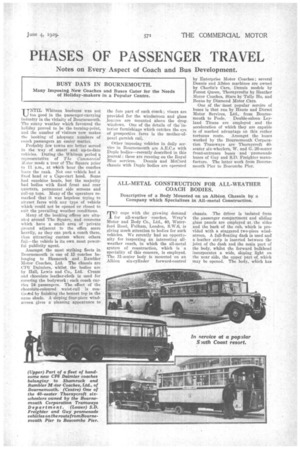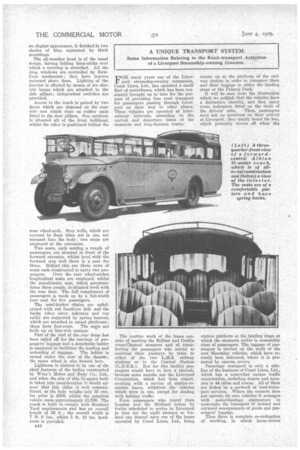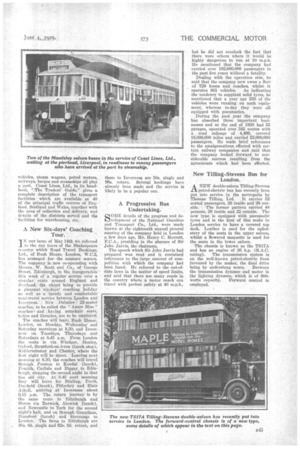PHASES OF PASSENGER TRAVEL
Page 69

Page 70

Page 71

If you've noticed an error in this article please click here to report it so we can fix it.
Notes on Every Aspect of Coach and Bus Development.
BUSY DAYS IN BOURNEMOUTH.
Many Imposing New Coaches and Buses Cater for the Needs of Holiday-makers in a Popular Centre.
UNTIL Whitsuu business was not too good in the passenger-carryinoindustrY in the vicinity of Bournemouth. The The sunny weather which favoured the holiday proved to be the turning-point, and the number of visitors now makes the booking of adequate nurabers of coach passengers an easier matter.
Probably few totns are better served in the way of smart and up-to-date vehicles. During the Whitson period a representative of The Commercial Motor made a tour of The Square prior to 11 a.m., at which hour the coaches leave the rank. Not one vehicle had a fixed -head or a Cape-cart hood. Some had sunshine heads, but the majority had bodies with fixed front and rear quarters, permanent side screens and roll-up tops. Many of the operators remarked that it was hopeless trying to attract fares with any type of vehicle which could not be opened or closed to suit the prevailing weather conditions.
Many of the booking offices are situated around The Square, and concerns which have a small area of private ground adjacent to the office scone heavily, as they can park a coach there, thus attracting custom where others fail—the vehicle is its own most powerful publicity agent.
Amongst the most striking fleets in Bournemouth is one of 15 coaches belonging to Shamrock and Rambler Motor Coaches, Ltd. The chassis are CP6 Daimlers, whilst the bodies are by Hall, Lewis and Co., Ltd. Cream and chocolate leather-cloth is used for covering the bodywork ; each coach carries 24 passengers. The effect of the chocolate-coloured waist-rail is contitieltd by finishing the bonnet top in the same shade. A sloping four-piece windscreen gives a pleasing appearance to
the fore part of each coach; .visors are provided for the windscreen and glass louvres are mounted above the drop windows. One of the details of the-interior furnishings which catches the eye of prospective fares is the ,mother-ofpearl garnish rail.
Other imposing vehicles in daily service in Bournemouth are A.E.C.s with Duple bodies—recently described in this journal; these are running on the Royal Blue services. Dennis and McCurd chassis with Duple bodies are operated by Enterprise Motor Coaches ; several Dennis and Albion machines are owned by Charlie's Cars, Dennis models by Forest Queen, Thornycrofts by Heather Motor Coaches, Stars by Tally Ho, and Beans by Diamond Motor Cars.
One of the most popular service of buses is that ran by Hants and Dorset Motor Services, Ltd., from Bournemouth to Poole. Double-saloon Leyland Titans are employed and the acceleration of which they are capable is of marked advantage on this rather tortuous route. Amongst the buses worked by the Bournemouth Corporation Tramways are Thornycroft 40seater six-wheelers, W. and G.-26-seater front-entrance buses and promenade buses of 'Guy and S.D. Freighter manufacture. The latter work from Bonrnemouth Pier to Boscombe Pier.
ALL-METAL CONSTRUCTION FOR ALL-WEATHER COACH BODIES.
Descriptive of a Body Mounted on an Albion Chassis by a Company which Specializes in All-metal Construction.
cope with the growing demand for all-weather coaches, Wray's Motor and Body Co., Ltd., 40, Waterford Road, Fulham, Loudon, S.W.6, is giving much attention to bodies for such vehicles. We recently had an opportri, nity for inspecting an interesting allweather coach, in which the all-metal system of construction, which is a speciality of this concern, is employed. The 31-seater body is mounted on an Albion six-cylinder forward-control chassis. The driver is isolated from the passenger compartment and sliding glass panels are employed at the sides and the back of the cab, which is provided with a staggered two-piece windscreen. A full-floating dash is used and a leather strip is inserted between the joint of the dash and the main part of the body, whilst the forward bulkhead incorporates a wide, sloping light on the near side, the upper part of which may be opened. The body, which has an elegant appearance, is finished in two shades of blue, separated by black mouldings.
The all-weather head is of the usual design, having folding hoop-sticks over which a covering is stretched. All the drop windows are controlled by Rawlings mechanism ; they have louvres mounted above them. Lighting of the interior is effected by means of six elece tric lamps which are attached to the side pillars ; independent switches are provided.
Access to the coach is gained by two doors which are disposed on the near side and which close on rubber pads fitted to the door pillars. One entrance is situated aft of the front bulkhead, whilst the other is positioned behind the
rear wheel-arch. Step wells, which are covered by flaps when not in use, are recessed into the body ; two steps are employed at the entrances.
Two seats, each seating a coeple of passengers, are situated in front of the forward entrance, whilst level, with the forward step well there is a seat for three. Behind this are three rows of seats each constructed to carry two pas
sengers. Over the rear wheel-arches longitudinal seats are employed, whilst the penultimate seat, which accommodates three people, is situated level with the rear door. The full complement of passengers is made up by a full-width rear seat for five passengers.
The semi-bucket chairs are upholstered with red furniture hide and the backs (they carry ashtrays and rug rails) are supported by spring bearers, which are attached to raised platforms ; these form foot-rests. The seats are built up on lace-web casings.
Part of the roof of the rear dome has been railed off for the carriage of passengers' luggage and a detachable ladder is employed to facilitate the loading and unloading of baggage. The ladder is stored under the rear of the chassis; the spare wheel is also housed here.
Lightness is claimed to be one of the chief features of the bodies constructed by Wray's Motor and Body Co., Ltd., and when the size of this 31-seater body is taken into consideration it would appear that this claim is well substantiated, as the body weighs only 35 cwt. Its price is £650, whilst the complete vehicle costs approximately L1,750. The coach is built to comply with Scotland Yard requirements and has an overall length of 26 ft.; the overall width is 7 ft. 6 ins., whilst 5 ft. 10 ins, headroom is provided.
n44
A UNIQUE TRANSPORT SYSTEM.
Some Information Relating to the Road-transport Activities of a Liverpool Steamship-owning Concern.
FOR many years one of the Liverpool steamship-owning companies, Coast Lines, Ltd., has operated a small fleet of motorbuses, which has been constantly brought up to date for the purpose. of providing free road transport for passengers passing through Liverpool on their way to other places. These vehicles are operated at intermittent intervals, according to the arrival and departure times of the steamers and long-distance trains.
The routine work of the buses consists of meeting the Belfast and Dublin cross-Channel steamers and of transferring the passengers who intend to continue their journeys by train to either of the two L.M.S. railway Stations or to the Central Station (L.N.E.R.). But for this facility passengers would have to hire a taxicab, because some mouths ago the Liverpool Corporation, which had been experimenting with a service of station-tostation buses, withdrew the vehicles which were in 'use, except for dealing with holiday traffic.
Even passengers who travel from Lortdou and the Midland towns by trains scheduled to arrive in Liverpool in time for the night steamer to Ireland can depend upon one of the buses operated by Coast Lines, Ltd., being drawn up at the platform of the railway station in order to transport them and their luggage to either the landing stage or the Princes Dock.
It will be seen from the illustration which we publish that the vehicles have a distinctive identity, and they carry route indicators fitted on the roofs of the drivers' cabs. Thus, passengers need ask 110 questions an their• arrival at Liverpool ; they simply board the bus, which promptly moves off when the station platform or the landing stage at which the steamers arrive is reasonably clear of passengers. The luggage of passengers is carried on the roofs of the new Maudslay vehicles, whiph have recently been delivered, where it is protected by camas covers.
Passenger transport is only a sideline of the business of Coast Lines, Ltd., which has a somewhat unique traffic organization, including depots and agencies in 44 cities and towns. All of them are linked by a network of road-trans' port. services. Where the concern does not operate, its Own vehicles it arranges with motor-haulage contractors to undertake the transport Of inward and outward consignments of goods and passengers luggage.
Thus there is complete co-ordination of working, in which horse-drawn
vehicles, steam wagons, petrol motors, railways, barges and steamships all play a part. Coast Lines, Ltd., in its handbook, "The Traders' Guide," gives. a complete description of the transport facilities which are available at 40 of the principal traffic centres of England, Scotland and Wales, together with the area of collection and delivery, and details of the districts served and the facilities for warehousing, etc, New Six-days' Coaching Tour.
JN our issue of May 14th We-referred to the day tours of the Shakespeare country which -Road Travel Bookings, Ltd., of Buell House, London, W.C.2, has arranged for the sunimer season. The companyis now co-operating with Messrs. W. Scott and Co., of George Street, Edinburgh, in the inauguration • this week of a regular service over a eiteular ronte around England and Scotland; the Object being to provide a pleasant --six-da:ys' coaching holiday as well as 'a speedy and comfortable road-tra-Vel service.between London and Invetness. New Daimler : 22-Seater coaches,: to be called the " ..ksure Blue." coaches and , having armchair seats, tables and libraries; are to be emploYed; The coaches will leave Bush •Thiuse, London, on Monday, Wednesday and Saturday mornings at 8.30, and Inverness on Tuesdays, Thursdays and Saturdays at 8.45 a.m. From London the route is via Windsor, Henley, Oxfords Stratford-on-Avon (lunch stop), Kidderminster and Chester, where the first night will be spent. Leaving next morning at 8.30, the coaches will travel through . Preston to Kendal (lunch), Penrith, Carlisle and Biggar to Edinburgh, Stopping the second night in that floe old city. At 8.45 next morning they will leave for Stirling, Perth, Dunkeld (lunch), Pi6ochry and Blair AtholL arriving at Inverness about 6.15 p.m. The., return journey is by the same route to Edinburgh and thence via Berwick, Alnwick (lunch), and Newcastle to York for the second night's halt, and on through Grantham, Stamford (lunch) and Stevenage to London. The fares to Edinburgh are ,SUs. 6d. single and 62s. 6d. return, and those to Inverness are 50s. single and 96s. return. Several bookings have already been made and the serviceis likely to be a popular one.
A Progressive Bus .
Undertaking.
SOME details of the progress and development of the National Omnibus and Transport Co., -Ltd., were made known at the eighteenth annual general meeting of the company held in London a few days ago, Mr. Henry. C. Merrett, E.C.A., presiding in the absence of Sir John Jarvis, the chairman.
The speech which Sir John Jarvis had prepared was read and it contained references to the -large amount of competition with which the company had been faced. He referred to the out-ofdate laws in the matter of speed limits, and said that there are many roads in the country where a motor coach can travel with perfect safety at 40 m.p.h., but he did not overlook the fact that there were others where it would be highly dangerous to run at 10 m.p.h. He mentioned that the company had carried over 192,000,000 passengers in the past five years without a fatality.
Dealing with the operation side, he said that the company now owns a fleet of 720 buses and coaches, whilst it operates 861 vehicles. As indicating the tendency to supplant solid tyres, he mentioned that a year ago 230 of the vehicles were running on such equipment, whereas to-day they were all equipped with pneumatics.
,During the past year the company has absorbed three important businesses and at the end of 1928 had 55 garages, operated over 342 routes with a road mileage of 4,496, covered 18,000,000 miles and carried 52,000,000 passengers. He made brief references to the amalgamations effected with certain railway companies and said that the company looked forward to considerable success resulting from the agreements which had been effected.
New Tilling-Stevens Bus for London.
ANEW double-saloon Tilling-Stevens :petrol-electric bus has recently been put into service in the metropolis by
Thomas Tilling, Ltd. It carries 52 seated passengers, 26 inside and 20 out
side. The former pattern carried 48 persons, 26 inside and 22 outside. The new type is equipped with pneumatic tyres and is the first of this make in London service to have a covered top deck. Leather is used for the upholstery of the seats in the upper saloon, whilst a flowered moquette is used for the seats in the lower saloon.
The chassis is known as the TS17A and has an engine of 36 h.p. (R.A.C.
rating). The transmission system is on the well-known petrol-electric lines favoured by the maker, the final drive being by underslung worm. Between the transmission dynamo and motor is the lighting dynamo, which is of 600.
watts capacity. Forward control is employed.




















































































































